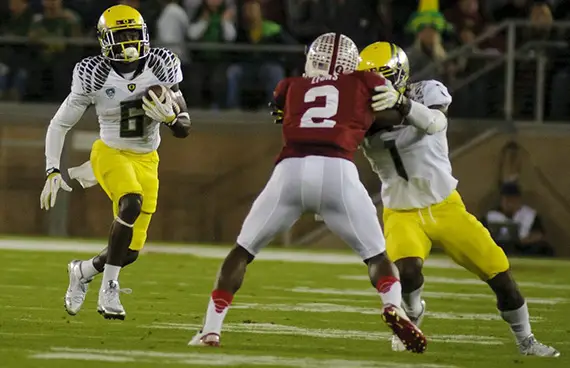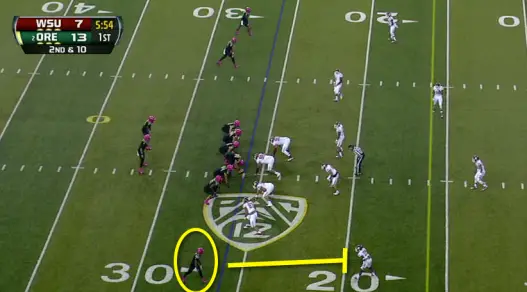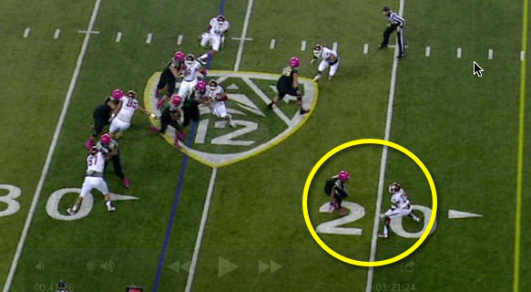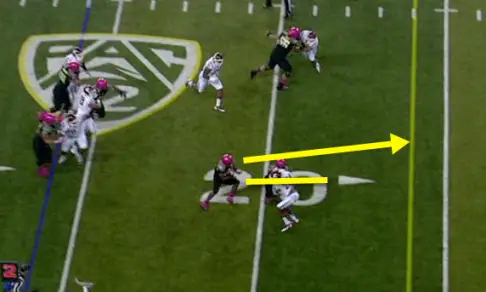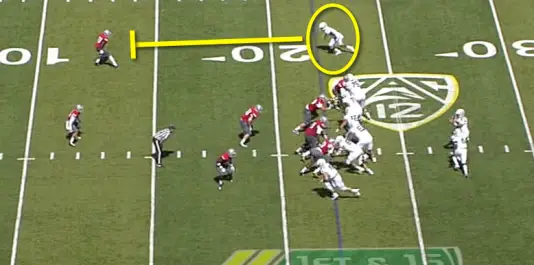When analyzing Oregon’s offense, it quickly becomes clear they have an uncommon number of explosive plays. According to ESPN’s PAC-12 Blog, an explosive play is defined as any play that gains 20 or more yards. In 2013 the Ducks were able to gain 20+ yards on a single play 106 times. 42 of these were rushing plays; 14 of which resulted in touchdowns.
Furthermore, each of Oregon’s top five rushers in 2013 averaged more than six yards per carry (YPC), with quarterback Marcus Mariota leading all rushers with a 7.45 YPC average.
So, in the spirit of off-season analysis, let’s pose a question: How does Oregon consistently produce big plays in the run game?
Offensive scheme is obviously a factor, and we know Oregon has established a strong tradition of turning out great backs in recent years. But there are many college football teams in the country with great offensive schemes and superior athletic talent. For instance, Stanford has great players and a more than capable run-game.
So what sets Oregon apart in terms of explosion plays?
Perimeter Blocking is the Key to Long Gains in the Run Game
During the Nicholls State game Fox Sports’ announcers commented on a conversation with Mark Helfrich where he provided some notes on measuring selflessness. In this conversation, the coach specifically noted receiver blocking.
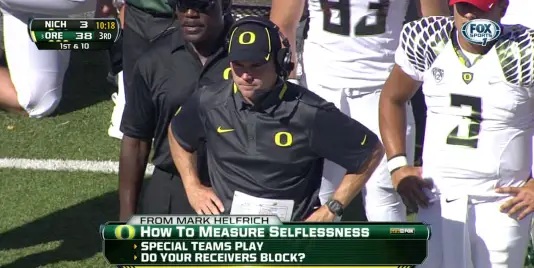
In the image above, Coach Helfrich is shown with a graphic, illustrating his measurement of selflessness. The following analysis of perimeter blocking by the Duck receiving corps indicates that Helfrich has been able to imprint the importance of perimeter blocking for team success. Let’s take a look at how this correlates to game-day execution and facilitates the number of explosion plays for Oregon in the run game.
Breaking Down the Stalk Block
In the plays below from the Washington State game, we note how Byron Marshall takes a handoff, clears the line of scrimmage, and makes a cut off a receiver’s block before continuing on to the end zone. The play is a great illustration of how good stalk blocking leads to great results in the run game. There are few key principles to the stalk block, which can be broken down into four components.
- Stance/Release
- Breakdown
- Mirror
- Finish
At the start of the play, Oregon is in a 3×1, one-back set. Duck receiver Keanon Lowe is split wide to the right. His blocking assignment is the cornerback covering him.
At the snap, Lowe takes a slow release and breaks down into an athletic position at six yards past the LOS. The coaching point here is to be patient and maintain an ability to mirror the defender.
At this stage of the play, Lowe has engaged the defender. When doing this, it is important for the receiver to keep active feet, roll his hips into the block and maintain his position between the defender and ball carrier. This provides a cutback lane and clear path to the end zone for the RB.

The following screenshots below, show the same play but from the end zone angle. This angle is great for seeing how the receiver’s block allows for the cutback — and — shows what the running back sees as the block is executed.
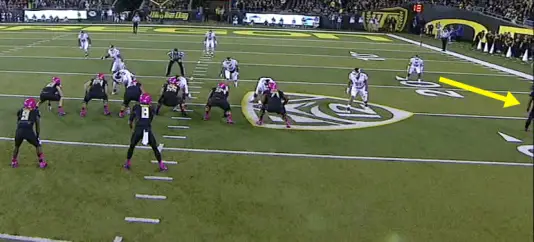 Again we see Lowe split to the right above.
Again we see Lowe split to the right above.
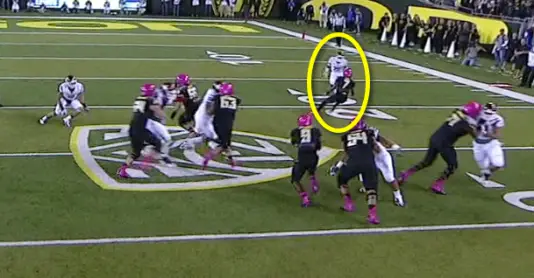 Above, we see Lowe after his release. He has gained inside leverage and is beginning to break down, so he can mirror the defender.
Above, we see Lowe after his release. He has gained inside leverage and is beginning to break down, so he can mirror the defender.
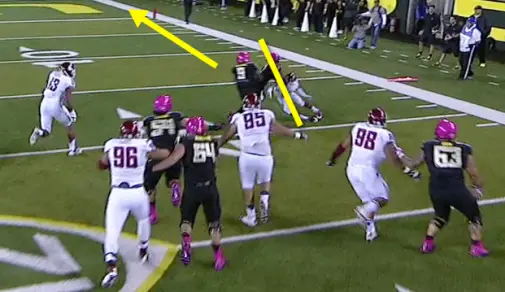 Lowe engages the defender and seals him to the outside, providing Marshall with the cutback lane.
Lowe engages the defender and seals him to the outside, providing Marshall with the cutback lane.

Bralon Addison also provides an excellent example of stalk blocking on a touchdown run by De’Anthony Thomas against Nicholls State.
Above, we see Addison is aligned to the right, and his blocking assignment is the cornerback.
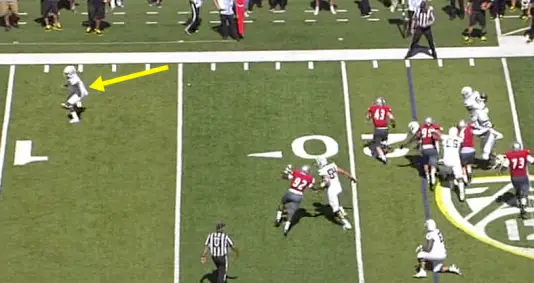 As the receiver closes in on the defender above, we see Addison break down into an athletic stance.
As the receiver closes in on the defender above, we see Addison break down into an athletic stance.
 Addison engages the defender by striking him with his hands. At this point he will remain engaged and works to keep himself in defender’s numbers. The goal is to keep his body between the defensive player and ball carrier.
Addison engages the defender by striking him with his hands. At this point he will remain engaged and works to keep himself in defender’s numbers. The goal is to keep his body between the defensive player and ball carrier.
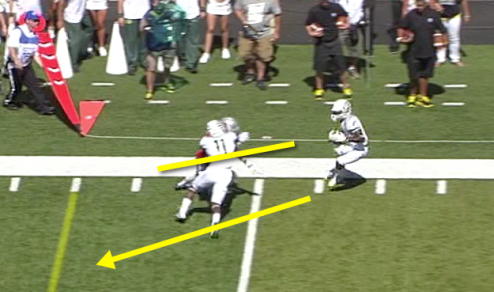 Above, we see that Addison has allowed the defender to gain leverage, but is ultimately successful with his block because he does not stop his feet. He continues to engage the defender and forces him to the outside and provides an opportunity for the back to make a cut.
Above, we see that Addison has allowed the defender to gain leverage, but is ultimately successful with his block because he does not stop his feet. He continues to engage the defender and forces him to the outside and provides an opportunity for the back to make a cut.
The video above, shows the plays analyzed in this article, as well as a few others. If you focus on the receivers in these clips, you will see many great examples of the stalk block and how Oregon executes the technique.
Teaching Receivers to Block Effectively
The skills outlined above, can be taught and are regularly drilled in practice.
In the video above, we see some of the common drills used to teach receivers to block effectively. Note how the focus is on footwork, breaking down, mirroring the defender, and being physical while engaged.
Final Thoughts
Becoming good blockers is the key component to good receiver play. If it is emphasized and developed, the dividends will be apparent on game day, as shown above. Teaching this starts with an emphasis on attitude. Blocking is an exercise in effort combined with good technique. If a receiver wants to become a good blocker and buys into the team concept, he will work at it and be tenacious in its execution. In light of this, coaches often emphasize the following points:
- Blocking is about attitude. Compete on every play and impose your will on the defender.
- Disrupt the opponent and be physical. Become the aggressor.
- End the play by moving your feet athletically and staying engaged with the defender.
- Block to the echo of the whistle.
If the above elements are taught and the players buy into the idea of selfless team play, there will be immediate results on game day. Oregon has been able to establish this culture and has developed receivers who are not only great playmakers when catching the ball, but great playmakers regardless of their assignment. The result is the high number of explosion plays enjoyed by Duck fans on Saturdays.
Coach Levi Steier
Albany, New York
http://optionfootball.net
(Top photo by Craig Strobeck)
[Ed. note: all screen shots are from video]
Levi Steier, (Football Analyst) after a collegiate playing career cut short by injuries, began his coaching career as a student assistant at Dakota State University. Since then he has coached primarily at the high school level. During this time he has been a head coach and has coordinated all three phases of the game. He is currently the owner of a web design business and the publisher at OptionFootball.net where he discusses many aspects of football, but regularly focuses on option oriented football topics. Coach Steier enjoys talking football and encourages anyone who would like to discuss the game or find more information to visit his site. You can follow Levi on twitter @OptionFootball, on his Facebook page and on Google+.

